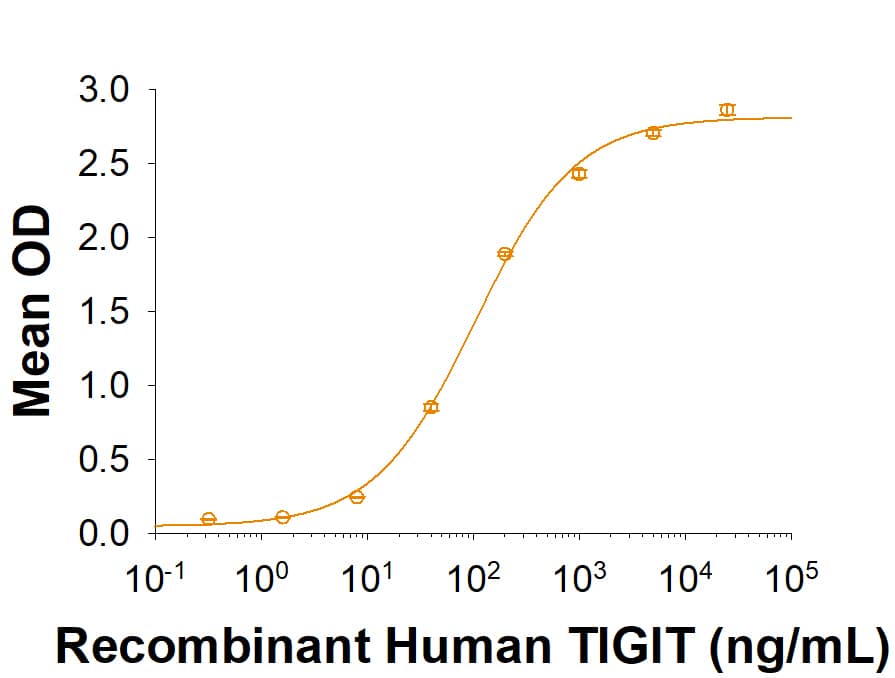Recombinant Human CD155/PVR His-tag Protein
R&D Systems, part of Bio-Techne | Catalog # 2530-CD

Key Product Details
Product Specifications
Source
Gly27-Asn343, with a C-terminal 6-His tag
Purity
Endotoxin Level
N-terminal Sequence Analysis
Predicted Molecular Mass
SDS-PAGE
Activity
When Recombinant Human CD155/PVR is coated at 2.5 μg/mL (100 μL/well), the concentration of Recombinant Human TIGIT Fc Chimera (Catalog # 7898-TGB) that produces 50% optimal binding response is 40-200 ng/mL.
Reviewed Applications
Read 2 reviews rated 5 using 2530-CD in the following applications:
Scientific Data Images for Recombinant Human CD155/PVR His-tag Protein
Recombinant Human CD155/PVR His-tag Protein Binding Activity
When Recombinant Human CD155/PVR (Catalog # 2530-CD) is immobilized at 2.5 µg/mL, Recombinant Human TIGIT Fc Chimera (Catalog # 7898-TGB) binds with an ED50 of 40-200 ng/mL.Formulation, Preparation and Storage
Carrier Free
What does CF mean?CF stands for Carrier Free (CF). We typically add Bovine Serum Albumin (BSA) as a carrier protein to our recombinant proteins. Adding a carrier protein enhances protein stability, increases shelf-life, and allows the recombinant protein to be stored at a more dilute concentration. The carrier free version does not contain BSA.
What formulation is right for me?In general, we advise purchasing the recombinant protein with BSA for use in cell or tissue culture, or as an ELISA standard. In contrast, the carrier free protein is recommended for applications, in which the presence of BSA could interfere.
Carrier: 2530-CD
| Formulation | Lyophilized from a 0.2 μm filtered solution in PBS with BSA as a carrier protein. |
| Reconstitution | Reconstitute at 100 μg/mL in sterile PBS containing at least 0.1% human or bovine serum albumin. |
| Shipping | The product is shipped at ambient temperature. Upon receipt, store it immediately at the temperature recommended below. |
| Stability & Storage | Use a manual defrost freezer and avoid repeated freeze-thaw cycles.
|
Carrier Free: 2530-CD/CF
| Formulation | Supplied as a 0.2 μm filtered solution in PBS. |
| Shipping | The product is shipped with dry ice or equivalent. Upon receipt, store it immediately at the temperature recommended below. |
| Stability & Storage | Use a manual defrost freezer and avoid repeated freeze-thaw cycles.
|
Background: CD155/PVR
References
- Mandai, K. et al. (2015) Curr. Top. Dev. Biol. 112:197.
- Mendelsohn, C.L. et al. (1989) Cell 56:855.
- Sato, T. et al. (2004) Genes to Cells 9:791.
- Meyer, D. et al. (2009) J. Biol. Chem. 284:2235.
- Koike, S. et al. (1990) EMBO J. 9:3217.
- Escalante, N.K. et al. (2011) Arterioscler. Thromb. Vasc. Biol. 31:1177.
- Xu, Z. and B. Jin (2010) Cell. Mol. Immunol. 7:11.
- Reymond, N. et al. (2004) J. Exp. Med. 199:1331.
- Maier, M.K. et al. (2007) Eur. J. Immunol. 37 :2214.
- Lozano, E. et al. (2013) J. Immunol. 191:3673.
- Yamashita-Kanemaru, Y. et al. (2015) J. Immunol. 194:5644.
- Mueller, S. and E. Wimmer (2003) J. Biol. Chem. 278:31251.
- Chan, C.J. et al. (2010) J. Immunol. 184:902.
- Qui, Q. et al. (2010) J. Immunol. 184:1681.
- Seth, S. et al. (2009) Eur. J. Immunol. 39:3160.
- Stanietsky, N. et al. (2009) Proc. Natl. Acad. Sci. USA 106:17858.
Long Name
Alternate Names
Entrez Gene IDs
Gene Symbol
UniProt
Additional CD155/PVR Products
Product Documents for Recombinant Human CD155/PVR His-tag Protein
Product Specific Notices for Recombinant Human CD155/PVR His-tag Protein
For research use only
